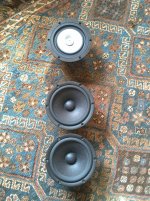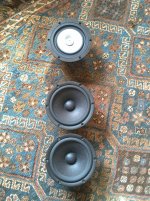So my DIY history so far has consisted of playing with existing models and designs in order to improve my understanding of design theory for loudspeakers.
As I'm finally in a place where I feel I understand properly what is required for driver selection/crossover design, I start coming to the questions of alignment and baffle step.
So my question is, if I take all the data from manufacturers spreadsheets, use that to model an ideal 'flat response' crossover, then put build it into a suitable cabinet, will I find that baffle step issues will hinder the outcome of the design?
Also, how do you then cater for baffle step? Is it essential to take FR/Imp measurements of the drivers in the cabinet and then design the crossover from there? That seems like the obvious solution, but the problem is when I look at a theoretical step at about 600Hz with simulated crossovers, any compensation network I use would make it nearly impossible to match driver phase, not to mention the reduced output, which would seem below most advertised specs for loudspeakers.... etc etc
I'm sure I'm being dim so please go easy on me, every time I google baffle step I find a guide that explains how bass rolls off as the waves wrap around the enclosure, or how I can use a passive filter in the crossover design to pad the higher frequencies down... I can't seem to find more clear information.
As I'm finally in a place where I feel I understand properly what is required for driver selection/crossover design, I start coming to the questions of alignment and baffle step.
So my question is, if I take all the data from manufacturers spreadsheets, use that to model an ideal 'flat response' crossover, then put build it into a suitable cabinet, will I find that baffle step issues will hinder the outcome of the design?
Also, how do you then cater for baffle step? Is it essential to take FR/Imp measurements of the drivers in the cabinet and then design the crossover from there? That seems like the obvious solution, but the problem is when I look at a theoretical step at about 600Hz with simulated crossovers, any compensation network I use would make it nearly impossible to match driver phase, not to mention the reduced output, which would seem below most advertised specs for loudspeakers.... etc etc
I'm sure I'm being dim so please go easy on me, every time I google baffle step I find a guide that explains how bass rolls off as the waves wrap around the enclosure, or how I can use a passive filter in the crossover design to pad the higher frequencies down... I can't seem to find more clear information.
So my question is, if I take all the data from manufacturers spreadsheets, use that to model an ideal 'flat response' crossover, then put build it into a suitable cabinet, will I find that baffle step issues will hinder the outcome of the design?
Yes.
Also be aware that the mfg. data alone probably won't let you design an "ideal" crossover. That takes measurement (and a lot more expertise than I have!).
Bill
Hi, you should take a look at this article,
Baffle Step Compensation
This gives a good explanation of the baffle step, and to boot explains the design of a baffle step compensation or BSC circuit that would allow you to not have to include BSC in the crossover network design.
Regards,
cT
Baffle Step Compensation
This gives a good explanation of the baffle step, and to boot explains the design of a baffle step compensation or BSC circuit that would allow you to not have to include BSC in the crossover network design.
Regards,
cT
Applying passive baffle step compensation will reduce loudspeaker sensitivity. The best way to counteract this is to double up on the mid/bass drivers (assuming you are building a 2-way), making an MTM (2-way) or TMM (2.5-way).
Full baffle step compensation will often result in a loudspeaker that is bass-heavy, though in practice the extent to which this becomes a problem is dependent on placement (proximity to room boundaries). The reason is that some of the step loss observed when modelling your baffle* gets negated by reflections off (mostly) nearby walls.
When you design your loudspeaker it is useful to know what the diffraction curve for your design (i.e., baffle layout) looks like. Then you can make a conscious decision about how much to compensate for it in your crossover design. The "right" amount is completely dependent on your specific application.
Lastly, I would like to echo the point mentioned above that you must work with actual acoustic measurements of the drivers in your own enclosure for best results. Good, calibrated measurement microphones are available for little money nowadays.
*See Edge or Baffle Diffraction Simulator.
Full baffle step compensation will often result in a loudspeaker that is bass-heavy, though in practice the extent to which this becomes a problem is dependent on placement (proximity to room boundaries). The reason is that some of the step loss observed when modelling your baffle* gets negated by reflections off (mostly) nearby walls.
When you design your loudspeaker it is useful to know what the diffraction curve for your design (i.e., baffle layout) looks like. Then you can make a conscious decision about how much to compensate for it in your crossover design. The "right" amount is completely dependent on your specific application.
Lastly, I would like to echo the point mentioned above that you must work with actual acoustic measurements of the drivers in your own enclosure for best results. Good, calibrated measurement microphones are available for little money nowadays.
*See Edge or Baffle Diffraction Simulator.
Yes, EDGE or Bagby's spreadsheet. PDSLite and SoundEasy.
Yes, only measurement in your prototype box in their listening position will let you fine tune the res ponce. I don't listen to my speakers on a pole in the side yard. I start there, but the really big advantage DIY has over bought is we CAN tune in in place.
BSC is absolutely critical, unless of course you are building wall plates. My next set are true bookshelf, as in will be in a case surrounded by books, so the step may be very shallow.
Yes, only measurement in your prototype box in their listening position will let you fine tune the res ponce. I don't listen to my speakers on a pole in the side yard. I start there, but the really big advantage DIY has over bought is we CAN tune in in place.
BSC is absolutely critical, unless of course you are building wall plates. My next set are true bookshelf, as in will be in a case surrounded by books, so the step may be very shallow.
One thing I've never been able to find is the effect of crossing over a 2-Way AT baffle step frequency.
On a 9" wide cabinet, which would be good for a 7" midwoofer, that would be 500Hz.
Now say we have a theoretical tweeter that could be crossed over at 500Hz LR2.
Assume the woofer and tweeter have the same rated sensitivity.
Do we even need to worry about BSC?
On a 9" wide cabinet, which would be good for a 7" midwoofer, that would be 500Hz.
Now say we have a theoretical tweeter that could be crossed over at 500Hz LR2.
Assume the woofer and tweeter have the same rated sensitivity.
Do we even need to worry about BSC?
Another way to deal with this is to select crossover points and driver locations on the enclosure to compensate. Allison did this back in the 1970s, if my memory is correct. These speakers were designed to be placed with their backs against the wall, or as close as practical. The tweeter and/or midrange would be located on the front of the cabinet in a conventional manner. The cabinet width and crossover frequency was chosen so that the mid/tweet drivers operated above the frequency where baffle step correction would be needed. The woofer(s), either side or top-firing, would be located as close as possible to the wall, neatly circumventing the baffle step issue.
The main drawback is the physical distance between the woofer and other drivers, which could introduce phase issues.
The main drawback is the physical distance between the woofer and other drivers, which could introduce phase issues.
One thing I've never been able to find is the effect of crossing over a 2-Way AT baffle step frequency.
On a 9" wide cabinet, which would be good for a 7" midwoofer, that would be 500Hz.
Now say we have a theoretical tweeter that could be crossed over at 500Hz LR2.
Assume the woofer and tweeter have the same rated sensitivity.
Do we even need to worry about BSC?
There are (mid)tweeters you can XO at 500 Hz. Althou usually you want to XO at less than the BS frequency (somewhere between 0.707 to 1 x F3(BS)). Woofer(s) should be 3 to 6 dB more sensitive than the midtweeter.
dave
If you look at the Cambridge Aero 2 measurements in HFW Feb 2014, this is exactly what they have done. You can see that the bass driver is about 3dB more sensitive than the BMR mid/tweeter, crossed over around 300Hz. The reviewer noted that the bass was slightly excessive.
6dB BSC correction appears to be way too high in real rooms
6dB BSC correction appears to be way too high in real rooms
6dB BSC correction appears to be way too high in real rooms
Unless a large room with speakers well free of the walls, yes.
dave
Too me the question is why was BSC not a problem for most commercial 2-ways with 2kHz+ crossovers and no attempt at BSC compensation.
BSC only became a popular issue when 2.5 ways became common
It's not so much about popularity; more about knowledge. Baffle step always existed, but had not always been identified/described.
For instance, in my first loudspeaker design I compensated for a strange midrange hump by adding some equalisation. I only later discovered I had done BSC.
Though more serious with the narrow cabinets that became popular in the 90sIt's not so much about popularity; more about knowledge. Baffle step always existed, but had not always been identified/described....
- Status
- This old topic is closed. If you want to reopen this topic, contact a moderator using the "Report Post" button.
- Home
- Loudspeakers
- Multi-Way
- Baffle step compensation.. how important is it?

